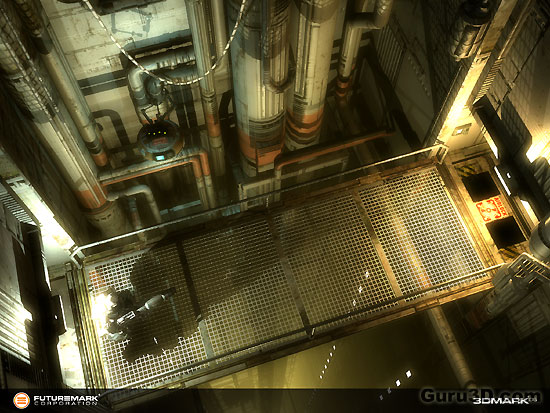Page 2
The test suite
The most important part of the 3Dmark series are of course the game demos that are the basis for the 3DMark end-score. In '05 there were three of them, with the introduction of Shader Model 3 a new timedemo was added named "Deep Freeze". That doesn't mean the other three game demos are the same though, no quite the contrary dear Watson. At all levels the 3D scenery has become more complex than you could ever imagine. That includes complex geometry; scenes with well over one million polygons per frame, complex and more shadows and more lights. All that rendered in real-time of course.
3DMark is all about DirectX 9.0c compatibility and yes, it requires a full DX9 compatible product to take all the shader lovin' to the next dimension. The new update is all about Shader 2.0 and 3.0. A new feature in the software is that it'll now, next to the default end-score, produce "sub scores." You will also see numbers for the following:
- Shader model 2.0 score
- HDR/Shader model 3.0 score
- Processor score
To measure these scores the software will take you through a suite of demos that'll stress either the GPU or CPU in various ways.
Most of all, the new 3Dmark 06 is all about shaders and HDR.
What is a shader? To render a three dimensional object; 2D on your monitor? We start off by building some sort of structure that has a surface, that surface is being built from triangles and why triangles? They are quick to calculate. How's each triangle being processed? Each triangle has to be transformed according to its relative position and orientation to the viewer. Each of the three vertices the triangle is made up of is transformed to its proper view space position. The next step is to light the triangle by taking the transformed vertices and applying a lighting calculation for every light defined in the scene. At last the triangle needs to be projected to the screen in order to rasterize it. During rasterization the triangle will be shaded and textured. Graphic processors like the NVIDIA's GeForce and ATI's Radeon series are able to perform a certain amount of these tasks. The first generation was able to draw shaded and textured triangles in hardware. The CPU still had the burden to feed the graphics processor with transformed and lit vertices, triangle gradients for shading and texturing, etc. Integrating the triangle setup into the chip logic was the next step and finally even transformation and lighting (TnL) was possible in hardware, reducing the CPU load considerably.
The big disadvantage was that a game programmer had no direct (i.e. program driven) control over transformation, lighting and pixel rendering because all the calculation models were fixed on the chip. And now we finally get to the stage where we can explain Shaders. Vertex and Pixel shaders allow developers to code customized transformation and lighting calculations as well as pixel coloring functionality. Each shader is basically nothing more than a pretty small program executed on the graphics processor to control either vertex or pixel processing. GeForce Series 6 and Radeon family X1000 and upwards have support for Shader model 3.0
What is HDR? HDR is something you all know from games like Far Cry, extremely bright lighting that brings a really cool cinematic effect to gaming. This effect is becoming extraordinarily popular. Valve recently released some HDR goodness in Half Life 2: Lost Coast which demonstrates the effect very well. HDR means High Dynamic Range. HDR facilitates the use of color values way beyond the normal range of the color palette in an effort to produce a more extreme form of lighting rendering. Typically this trick is used to contrast really dark scenery. Extreme sunlight, over-saturation or over exposure is a good example of what exactly is possible. The most simple way to describe it would be controlling the amount of light used present in a certain position in a 3D scene. HDR is already present in Far Cry, Half Life 2: Lost Coast and will be available in titles like Unreal 3 and now 3DMark06.
What we'll do is walk though the four 3DMark06 gamedemo's one by one and and show you the differences between the old and the new version. We'll briefly look at the newly introduced features.

